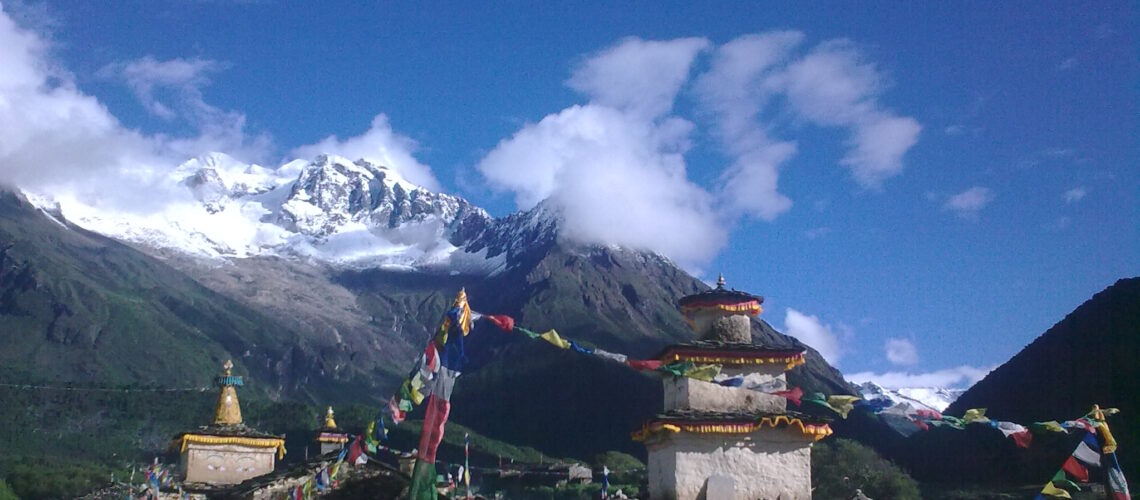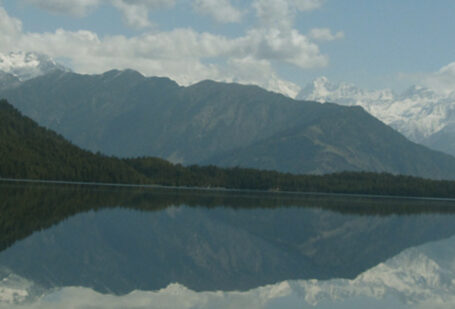
Tsum Valley Trek
- based on 0 reviews
- Book This Trip
- Print the trip details
- Trip Grade: Easy
- Meals: (breakfast, lunch, and dinner)
- Accomodation: Basic camping or guest house
- Transportation: included
Overview
Considered as one of the most remote, less trodden and secret lands of Nepal, the Tsum Valley Trek s is a majestic experience that takes you to the remote and mystical depths of Nepal. Experience secluded trails, the secret Tibetan Buddhist lands, majestic surroundings and the mysterious valley of Tsum with the Alpine Paradise Treks and Expedition.
The Tsum valley was a restricted region until recently. The major attraction of the Tsum Valley trek are the roundabout views of the perfect peaks like the Ganesh Himal, Sringi Himal and Boudha him standing proud and tall. The region was one a part of Tibet and the diverse landscapes of this region are something out of a movie, unparalleled to any. With less number of people, this area is relatively virgin.
Start the trek from Arughat and descend through the Budhi Gandaki Valley through terraced fields and hill villages to reach the hidden Tsum Valley, explore mind boggling glacial lakes and rivers, alpine forests and visit the Gombas like the Rachen Gompa, Mun gompa, and Dephyudonma Gompa.
Experience the way of living of ethnic people here and explore the practice of polyandry that the Tsombo people living here are famous for. Come experience a trekking journey to this hidden, mystical valley with the Alpine Paradise Treks and Expedition and experience true Nepal now.
Best Season:
The best season to trek to Tsum Valley, it is recommended to plan your trip between September to November or March to May, as the weather is generally dry and clear during these months, making it easier to trek and enjoy the scenic beauty of the region.
Permits and regulations for Tsum Valley Trek in Nepal are as follows:
- Restricted Area Permit: Tsum Valley is a restricted area, and all foreign trekkers must obtain a Restricted Area Permit (RAP) from the Nepal Immigration Department in Kathmandu. The permit is valid for a minimum of two people, and a registered guide must accompany the group.
- Manaslu Conservation Area Permit: Tsum Valley Trek falls within the Manaslu Conservation Area, and all trekkers must obtain a Manaslu Conservation Area Permit (MCAP) from the Nepal Tourism Board or the Conservation Area Project offices.
- Annapurna Conservation Area Permit: Trekkers who plan to take the Tsum Valley Trek via the Manaslu Circuit and end at Dharapani or Besishahar must also obtain an Annapurna Conservation Area Permit (ACAP) from the same offices.
- TIMS Card: Trekkers must also obtain a Trekkers’ Information Management System (TIMS) card, which can be acquired at the Nepal Tourism Board or Trekking Agencies’ Association of Nepal (TAAN) offices in Kathmandu or Pokhara
Outline Itinerary
Day 1: Arrival in Kathmandu and transfer to hotel
Day 2: Sightseeing in Kathmandu
Day 3: Drive to Arughat (550 m) and trek to Soti Khola (700m)
Day 4: Trek to Machha Khola (900m)
Day 5: Trek to Jagat (1340m)
Day 6: Trek to Lokpa (2240m)
Day 7: Trek to Chumling (2386m)
Day 8: Trek to Chhokangparo (3010m)
Day 9: Trek to Nile (3361m)
Day 10: Trek to Mu Gompa (3700m)
Day 11: Exploration day in Mu Gompa and visit to nearby monasteries
Day 12: Trek back to Chhokangparo
Day 13: Trek to Chumling
Day 14: Trek to Soti Khola
Day 15: Drive back to Kathmandu
Request a Custom Itinerary:
To create your custom itinerary, please click on this link. Our experienced travel consultants are ready to help you design a personalized travel experience that matches your unique interests and preferences.
Day 1: Arrival in Kathmandu and transfer to hotel:
On the first day, you will arrive at the airport in Kathmandu, where you will be welcomed by our representative and transferred to your hotel. You can spend the rest of the day resting and recovering from your journey.
Day 2: Sightseeing in Kathmandu:
On the second day, you will go on a sightseeing tour of Kathmandu. You will visit some of the city’s most famous landmarks and temples such as the Pashupatinath Temple, a UNESCO World Heritage Site and one of the most sacred Hindu temples in the world, and the Boudhanath Stupa, which is one of the largest stupas in the world and a popular destination for Buddhist pilgrims. You will also visit Swayambhunath Stupa (Monkey Temple), another UNESCO World Heritage Site, which is known for its monkeys and panoramic views of the city.
Day 3: Drive to Arughat (550 m) and trek to Soti Khola (700m):
On the third day, you will begin your trek by driving to Arughat, which is the starting point of the trek. From there, you will trek to Soti Khola, which is located at an altitude of 700m. This will be an easy walk along the river and will take approximately 6-7 hours.
Day 4: Trek to Machha Khola (900m):
On this day, you will continue your trek to Machha Khola, which is located at an altitude of 900m. You will follow the Budhi Gandaki River, and the trek will take approximately 5-6 hours. You will pass through several small villages along the way.
Day 5: Trek to Jagat (1340m):
On the fifth day, you will continue your trek to Jagat, which is located at an altitude of 1340m. The trail will take you through terraced fields and small villages, and the trek will take about 6 hours.
Day 6: Trek to Lokpa (2240m):
Today, you will trek to Lokpa, which is located at an altitude of 2240m. The trail is steep and ascends through rhododendron forests. The trek will take about 7 hours.
Day 7: Trek to Chumling (2386m):
On the seventh day, you will trek to Chumling, a small village located near the banks of the Budhi Gandaki River. The trek will take about 5-6 hours, and you will pass through several small villages along the way.
Day 8: Trek to Chhokangparo (3010m):
On the eighth day, you will continue your trek to Chhokangparo, following a steep ascent. The trek will take about 6 hours, and you will pass through beautiful landscapes and traditional Tibetan-style houses.
Day 9: Trek to Nile (3361m):
On the ninth day, you will continue your trek to Nile, passing through rhododendron forests and small villages. You will also pass the village of Chhule, which is known for its ancient Tibetan Buddhist Monastery, and the holy waterfalls of Phurpe Chhyachu. The trek will take about 7 hours.
Day 10: Trek to Mu Gompa (3700m):
On the tenth day, you will trek to Mu Gompa, a remote Buddhist monastery located in the heart of the Tsum Valley. The trek will take about 6 hours, and you will pass through traditional Tibetan-style villages and fields.
Day 11: Exploration day in Mu Gompa and visit to nearby monasteries
This day will be dedicated to exploring Mu Gompa and the surrounding area. You will have the opportunity to interact with the monks and learn about their daily routines and practices. You will also visit nearby monasteries such as Dephyudonma Gompa, which is believed to be over 700 years old, and visit some of the local villages. In the evening, you will return to Mu Gompa and spend another night at the guesthouse.
Day 12: Trek back to Chhokangparo
On this day, you will begin your trek back to Chhokangparo. The trail will take you through the same rugged landscapes and traditional villages as before. You will stop for lunch in the village of Rachen Gompa before continuing your trek to Chhokangparo, where you will spend the night.
Day 13: Trek to Chumling
Today, you will continue your trek back to Chumling, following the same trail as before. You will pass through several small villages and cross a few suspension bridges over the Budhi Gandaki River. The trek will take about 5-6 hours, and you will stay overnight in Chumling.
Day 14: Trek to Soti Khola
On the fourteenth day, you will finish your trek by walking back to Soti Khola. The trek will take about 5 hours, and you will pass through several small villages and cross a few suspension bridges over the Budhi Gandaki River. You will spend your final night of the trek in Soti Khola.
Day 15: Drive back to Kathmandu
On the final day, you will drive back to Kathmandu, where you will be transferred to your hotel or the airport. You can spend the rest of the day exploring the city or doing some last-minute shopping for souvenirs. In the evening, you will attend a farewell dinner with your trekking crew and celebrate the completion of your trek.
Inclusions:
- Accommodation (tea house or camping)
- Meals (breakfast, lunch, and dinner)
- Local transportation (airport transfer, trekking transportation)
- Trekking guide and porter services
- Necessary permits and fees
Exclusions:
- International airfare
- Travel insurance
- Personal expenses (alcohol, snacks, souvenirs, etc.)
- Tips for guide and porter
- Emergency evacuation expenses
- Any other expenses not mentioned in the inclusions list.
0 Reviews on Tsum Valley Trek View All
Equipment List:
- Hiking boots and socks
- Waterproof jacket and pants
- Warm clothing (fleece jacket, hat, gloves)
- Lightweight clothing (t-shirts, shorts, pants)
- Sleeping bag
- Headlamp and extra batteries
- Sun hat, sunglasses, and sunscreen
- First aid kit
- Personal hygiene items (toothbrush, toothpaste, wet wipes, hand sanitizer, etc.)
- Hydration system (water bottles or hydration bladder)
- Trekking poles
- Trash bag
- Optional: camera, book, playing cards, etc.
FAQs:
- What is the best time to go for the Tsum Valley Trek?
- The best time to go for the Tsum Valley Trek is from late September to November, as the weather is dry and clear with mild temperatures.
- How difficult is the Tsum Valley Trek?
- The Tsum Valley Trek is considered to be a moderate to challenging trek with daily hiking of 5 to 8 hours and steep ascents and descents.
- How can I get a permit for the Tsum Valley Trek?
- A special permit is required to enter the Tsum Valley, which can be obtained in Kathmandu or Pokhara. The cost of the permit is around US$35-40 per person.
- Is it necessary to hire a guide or porter for the Tsum Valley Trek?
- Hiring a guide or porter is not necessary, but it is highly recommended as they have local knowledge and can provide valuable assistance during the trek.
- What is the best way to acclimatize during the Tsum Valley Trek?
- The best way to acclimatize during the Tsum Valley Trek is to follow a slow pace and take rest days to allow the body to adjust to the increasing altitude. Staying hydrated and avoiding alcohol and other dehydrating substances can also help with acclimatization.
- What kind of food and accommodation is available during the Tsum Valley Trek?
- During the Tsum Valley Trek, basic food and accommodation is available in teahouses, including rice, vegetables, lentils, pasta, and potatoes. The teahouses offer simple rooms with shared bathrooms, or it is possible to camp.












Leave a Reply